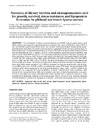Identificador persistente para citar o vincular este elemento:
https://accedacris.ulpgc.es/jspui/handle/10553/576
| Título: | Necessity of dietary lecithin and eicosapentaenoic acid for growth, survival, stress resistance and lipoprotein formation in gilthead sea bream Sparus aurata | Autores/as: | Liu, Jingle Caballero, Maria José Izquierdo, Marisol El-Sayed Aly, Tamer Hernández-Cruz, Carmen María Valencia, Antonio Fernández-Palacios, Hipólito |
Palabras clave: | Dorada (Peces) Alimentación Lipoproteínas Stress (Fisiología) Ácidos grasos, et al. |
Fecha de publicación: | 2002 | Publicación seriada: | Fisheries Science | Resumen: | The substitution of dietary docosahexaenoic acid (DHA) with eicosapentaenoic acid (EPA) reduces larval growth in gilthead sea bream. However, the value of EPA when dietary DHA is able to meet the requirements of the larvae has not been sufficiently studied. Dietary phosphoacylgliceride levels also affect fish growth and it has been suggested that they enhance lipid transport in developing larvae. The present experiment was carried out to further study the effect of dietary lecithin and eicosapentaenoic acid on growth, survival, stress resistance, larval fatty acid composition and lipid transport, when DHA is present in the microdiets of gilthead sea bream. Eighteen thousand gilthead sea bream larvae of 4.99 ± 0.53 mm total length were fed three microdiets tested by triplicate: a control diet [2% soybean lecithin (SBL) and 2.89% EPA], a low EPA diet (2% SBL and 1.63% EPA) and a no SBL diet (0% SBL and 2.71% EPA). Handling, temperature and salinity tests determined larval resistance to stress. The results show that when dietary DHA levels are high, but dietary arachidonic acid (ARA) levels are about 0.2%, EPA is necessary to improve larval growth, and survival. Larval EPA content, but not DHA or ARA, was affected by dietary EPA levels. Increased dietary EPA improved larval stress resistance to handling and temperature tests, which could be related to its possible role as a regulator of cortisol production, whereas it did not affect stress resistance after salinity shock.Larvae fed the no SBL diet showed a lower lipid content characterized by a low proportion of saturated and monounsaturated fatty acids, together with a significant eduction in the appearance of lipoprotein particles in the lamina propria and in the size of such particles, denoting a critical reduction in the dietary lipid transport and utilization, and lower larval growth and survival rates. | URI: | https://accedacris.ulpgc.es/handle/10553/576 | ISSN: | 0919-9268 | DOI: | 10.1046/j.1444-2906.2002.00551.x | Fuente: | Fisheries Science [ISSN 0919-9268], v. 68, p. 1165-1172 |
| Colección: | Artículos |
Citas SCOPUSTM
86
actualizado el 08-jun-2025
Citas de WEB OF SCIENCETM
Citations
75
actualizado el 08-jun-2025
Visitas
180
actualizado el 18-ene-2025
Descargas
326
actualizado el 18-ene-2025
Google ScholarTM
Verifica
Altmetric
Comparte
Exporta metadatos
Los elementos en ULPGC accedaCRIS están protegidos por derechos de autor con todos los derechos reservados, a menos que se indique lo contrario.
